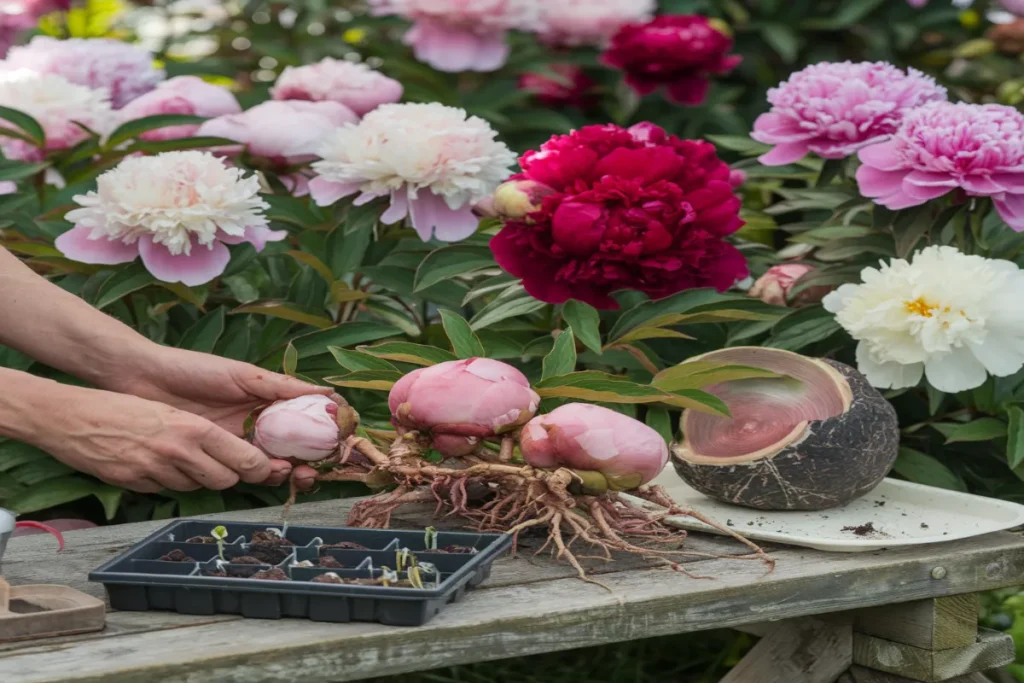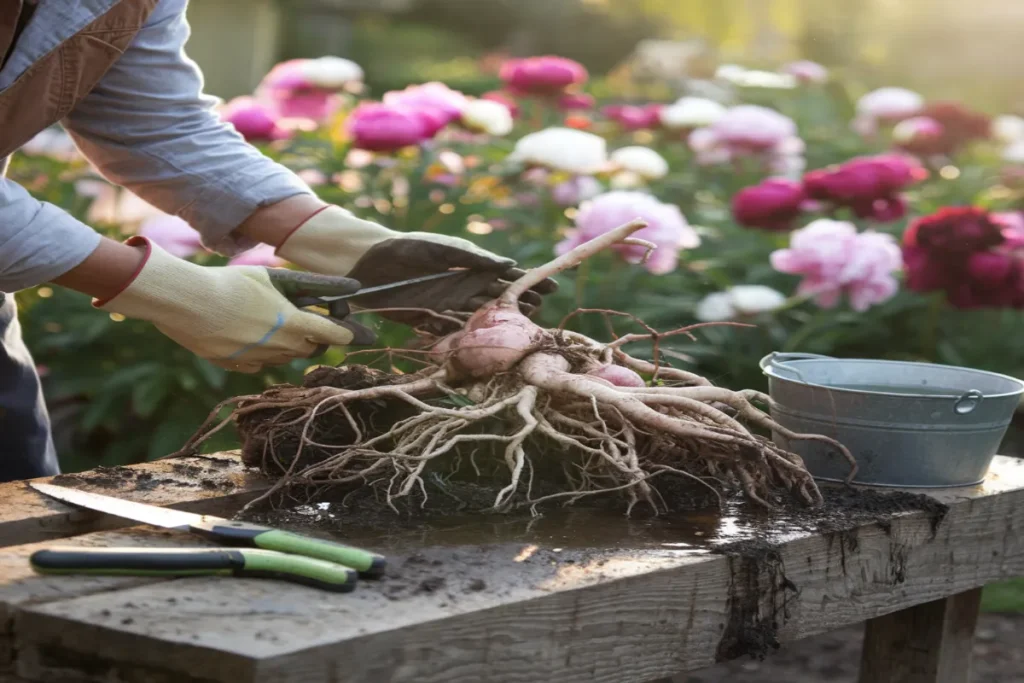Martha Peterson’s garden in Vermont was famous among local gardeners. Her peony collection, passed down through generations, showed her love for these plants. When neighbors asked about peony propagation, she shared her secrets, turning one plant into a garden full of blooms.
Learning how to propagate peonies is rewarding for garden lovers. These plants can live for over 100 years with the right care. Gardeners can grow peonies through division, seed, or root cuttings.
Can you grow peonies in your garden? Yes, you can! These plants thrive in USDA Zones 3-8, covering most of the U.S. Whether you have herbaceous or tree peonies, knowing how to propagate them will enhance your garden’s beauty.
Before starting, remember peonies need patience. Spring-planted peonies may take a year longer than fall-planted ones. It can take 1 to 2 years for new divisions to fully grow. Knowing the plant’s growth habits and providing the best conditions is key.
Table of Contents
Understanding Peonies: An Overview
Peonies are stunning perennial flowering plants that captivate gardeners with their lush blooms and diverse characteristics. These remarkable plants have complex reproduction methods that fascinate both novice and experienced gardeners. Knowing how peonies reproduce is key for successful cultivation and propagation.
Peonies are classified into three primary types, each with unique growth patterns and reproductive strategies:
- Herbaceous Peonies: Most common garden variety
- Tree Peonies: Woody shrub-like plants
- Itoh (Intersectional) Peonies: Hybrid varieties
Common Peony Varieties
Exploring how peonies reproduce reveals multiple propagation techniques. These plants can reproduce through:
- Seed production
- Root division
- Grafting
Peony Growth Habits
Peonies show remarkable adaptability across different environments. Most varieties thrive in USDA hardiness zones 3-8, with growth characteristics that vary by type:
- Herbaceous peonies typically grow 3 feet tall
- Tree peonies can reach 4-6 feet in height
- Intersectional hybrids average 2-2.5 feet tall
Ideal Growing Conditions
Successful peony reproduction requires specific environmental conditions. These plants prefer:
- Full sun to partial shade
- Well-draining, fertile soil
- Neutral to slightly alkaline pH levels
- Consistent moisture without waterlogging
“Patience is key when propagating peonies – some methods can take several years before producing flowering plants.”
When to Propagate Peonies
Propagating peonies needs careful timing and knowing the plant’s growth cycle. Gardeners wanting to know if they can root peonies must understand the best times. The best time to root a peony cutting is during certain seasonal changes.
Seasonal Propagation Windows
Peony propagation needs precise timing for plant health and growth. The best times for propagation are:
- Late Summer to Early Fall: Best for dividing herbaceous peonies
- After the flowers stop blooming
- Before the first frost of the season
Identifying Healthy Peonies for Propagation
Not all peonies are ready for propagation. Gardeners should look for signs of plant health:
- A strong root system with many healthy buds
- No signs of disease or pests
- Plants that are three to four years old
- Flowers that have finished blooming
“Successful peony propagation starts with choosing the right plant at the right time.” – Garden Experts
Different peony types need different approaches. Herbaceous peonies are best divided in autumn. Tree peonies do well with layering. Each division should have at least three viable buds and a lot of root mass for success.
Understanding peony propagation increases your chances of a beautiful garden. Patience and careful observation are essential for this rewarding skill.
Methods of Propagating Peonies

Gardeners looking to grow peonies from cuttings have several methods to try. Each has its own benefits and challenges. This can help you grow more peonies.
Division Method: The Most Reliable Approach
Division is the simplest and most reliable way to propagate peonies. It works best for herbaceous peonies and gives quick results.
- Best performed in early autumn
- Requires dividing root clumps with 3-5 eyes
- Ensures genetic consistency of parent plant
Seed Propagation: Patient Gardener’s Method
Seed propagation takes a lot of patience but can lead to new peony varieties. It’s a chance to create something unique.
| Seed Propagation Details | Specifics |
|---|---|
| Germination Time | 5-7 years to first flower |
| Indoor Seed Starting | 70-80°F for 3 months, then cold stratification |
| Planting Depth | 1-2 inches underground |
Grafting Technique: Specialized Approach
Grafting is a specialized method mainly for tree peonies. It needs advanced skills and knowledge.
“Patience is the gardener’s greatest virtue when propagating peonies.” – Gardening Wisdom
Each method has its own advantages. Choose the one that fits your gardening level and goals.
How to Divide Peonies Properly
Dividing peonies is a key part of growing these plants. It helps mature plants grow new and keeps your garden looking great. Knowing how to divide them right is important for their health and beauty.
Essential Tools for Peony Division
To divide peonies well, you need the right tools:
- Sharp spade
- Clean pruning shears
- Garden knife
- Gardening gloves
- Bucket of water
Optimal Division Techniques
When is the best time to take peony cuttings? Late summer to early fall is the best time. Here’s what to do:
- Wait until peony shoots reach 6-8 inches tall
- Dig around the plant’s drip line, about 15 inches from the center
- Carefully lift the entire root system
- Gently wash roots to examine structure
| Division Characteristic | Recommended Standard |
|---|---|
| Minimum Eyes per Division | 3-5 growth buds |
| Root System Requirement | Substantial, healthy roots |
| Stem Length | 8 inches remaining |
Pro Tip: Remember, divided peonies need time to grow. “First year sleep, second year creep, third year leap”. Be patient with these beautiful plants.
Successful peony division requires precision, patience, and proper technique.
New peonies might not bloom right away. They’ll bloom fully in about three years. Taking good care of them during this time will help them grow strong and bloom beautifully.

Preparing Your Soil for Peonies
Creating the perfect soil environment is key for growing peonies from cuttings. Peonies need specific soil conditions to thrive and bloom beautifully. Knowing what soil they prefer can make a big difference.
Essential Soil Characteristics
Peonies love well-draining, fertile soil with a slightly acidic to neutral pH. The best pH is between 6.5 and 7.0. This helps them absorb nutrients and grow strong roots.
- Ensure excellent drainage to prevent root rot
- Select loamy soil rich in organic matter
- Avoid heavy clay or sandy soils
Soil Amendment Strategies
To grow peonies from cuttings, preparing the soil is essential. Organic amendments can greatly improve soil quality and fertility.
| Amendment Type | Benefits | Application Rate |
|---|---|---|
| Compost | Improves soil structure | 2-3 inches mixed into top 12 inches |
| Aged Manure | Adds nutrients | 1-2 inches before planting |
| Bone Meal | Provides phosphorus | 1/2 cup per planting hole |
“The secret to thriving peonies lies beneath the surface – in the soil’s quality and preparation.”
When thinking about growing peonies from cuttings, remember soil quality is very important. The right amendments create a great environment for strong roots and healthy plants.
Caring for Newly Planted Peonies
After planting your peonies, it’s important to care for them well. This ensures they grow strong and bloom beautifully. Whether you’re starting peonies from cuttings or learning how to root them, knowing how to care for them is key.
Nurturing Your Young Peony Plants
New peonies need gentle care to grow strong roots. Young plants are very sensitive in their first years. They need special care to grow well.
Mulching Techniques
Mulching is vital for new peonies. Here’s how to mulch them right:
- Apply 2-3 inches of organic mulch around the plant
- Keep mulch about 2 inches from plant stems
- Use bark chips, straw, or well-aged compost
- Refresh mulch every year to keep moisture in
Fertilization Tips
Right fertilization is key for peony health. Here are some tips:
- Use a balanced, low-nitrogen fertilizer in early spring
- Apply one cup of bonemeal per plant at the base
- Avoid over-fertilizing, which can reduce flowering
- Opt for organic compost as a gentle nutrient source
“Patience is key when establishing peony plants – they may take several years to reach full blooming.
When rooting peony cuttings, keep them moist and protect from extreme temperatures. Watch them closely. These plants need time to grow strong.
Common Mistakes in Peony Propagation
Propagating peonies needs careful attention. Gardeners often face challenges that can harm their plants. Knowing these common mistakes helps grow strong and beautiful peonies.
Overwatering Dangers
One big mistake is watering too much. Peonies don’t like too much water. Too much can cause root rot. It’s best to give them only 1 inch of water weekly when they’re new.
- Too much water hurts the roots
- It’s a perfect place for diseases to grow
- It stops oxygen from getting to the roots
Pest Control Neglect
Not taking care of pests can harm your peonies. Pests like nematodes, scales, and Japanese beetles can ruin your efforts.
“Prevention is always more effective than treatment in garden management.”
- Check your peony cuttings in water for pests often
- Use natural ways to fight pests
- Clean your tools well after using them on plants
Critical Propagation Insights
Propagating peonies needs to be precise. Here are some important tips:
- Make sure each root ball has 3-5 growth eyes
- Cuttings should be as thick as a pencil
- Plant them at the right depth for blooming
By avoiding these mistakes, gardeners can grow healthy, vibrant peonies.
Frequently Asked Questions
Can you grow a peony from a cutting?
No, peonies do not grow from stem cuttings like some other plants. Instead, they are best propagated by dividing the roots (rhizomes) in the fall. If you try to root a stem cutting, it will not develop into a new plant.
How do you multiply peonies?
The best way to multiply peonies is by dividing the root clump in the fall. Here’s how:
Dig up a mature peony plant carefully.
Shake off excess soil to see the root structure.
Use a sharp knife to cut sections, making sure each has at least 3-5 eyes (buds) and strong roots.
Replant the divisions 1-2 inches deep in well-draining soil.
Water lightly and wait—new growth will appear in spring!
Peonies take time to establish, but once settled, they bloom for decades.
How to collect peony seeds?
Peony seeds can be collected in late summer to early fall:
Let the seed pods dry on the plant until they turn brown and split open.
Remove the seeds (they will be black or dark brown).
Rinse and dry them, then plant them immediately or store them in a cool, dry place.
Peony seeds take 2-5 years to grow into blooming plants, so patience is key!
Do peonies spread on their own?
No, peonies do not spread aggressively like some perennials. They grow from a central root system and slowly get bigger over time. If left alone, a mature peony can form a large clump but will not send out runners or take over a garden. If you want more peonies, you’ll need to divide them manually.
Does cutting peonies encourage growth?
Yes! Deadheading spent blooms redirects energy back into the roots rather than seed production, which can lead to better blooms next year. However:
Do not cut back the leaves until fall—they feed the roots.
Cut flowers for vases sparingly—taking too much foliage weakens the plant.
Light pruning can help, but peonies don’t need frequent trimming to thrive.
Can I divide peonies after they bloom?
It’s best to wait until fall (September to October) to divide peonies. Dividing them right after blooming can stress the plant and affect next year’s flowers. Fall gives them time to settle in before winter.

